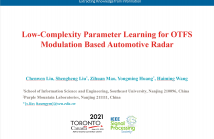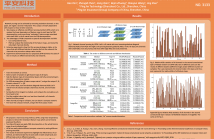
ICASSP 2021 - IEEE International Conference on Acoustics, Speech and Signal Processing is the world’s largest and most comprehensive technical conference focused on signal processing and its applications. The ICASSP 2021 conference will feature world-class presentations by internationally renowned speakers, cutting-edge session topics and provide a fantastic opportunity to network with like-minded professionals from around the world. Visit website.

- Read more about Low-Complexity Parameter Learning for OTFS Modulation Based Automotive Radar
- Log in to post comments
Orthogonal time frequency space (OTFS) as an emerging modulation technique in the 5G and beyond era exploits full time-frequency diversity and is robust against doubly-selective channels in high mobility scenarios. In this work, we consider an OTFS modulation based automotive joint radar-communication system and focus on the design of low-complexity parameter estimation algorithm for radar targets.
- Categories:
 33 Views
33 Views
- Read more about Meta Ordinal Weighting Net For Improving Lung Nodule Classification
- Log in to post comments
- Categories:
 13 Views
13 Views
- Read more about LAYER-WISE INTERPRETATION OF DEEP NEURAL NETWORKS USING IDENTITY INITIALIZATION
- Log in to post comments
Poster.pdf
- Categories:
 8 Views
8 Views
- Read more about Grid Optimization for Matrix-based Source Localization under Inhomogeneous Sensor Topology
- Log in to post comments
- Categories:
 3 Views
3 Views
- Read more about DUAL-STREAM NETWORK BASED ON GLOBAL GUIDANCE FOR SALIENT OBJECT DETECTION
- Log in to post comments
High-level features can help low-level features eliminate semantic ambiguity, which is crucial for obtaining the precise salient object. Some methods use high-level features to pro vide global guidance for some layers of the network. However, there remain several problems: (1) the global guidance has not been fully mined, which leads to its limited capacity; (2) the semantic gap between global guidance and lowlevel features is ignored, and simple merging methods will cause feature aliasing.
icassp海报.pdf
- Categories:
 7 Views
7 Views
- Read more about NETWORK PRUNING USING LINEAR DEPENDENCY ANALYSIS ON FEATURE MAPS
- Log in to post comments
Network pruning can be achieved by removing redundant channels. In this paper, we regard a channel ‘redundant’ if its output is linearly dependent with respect to those of other channels. Inspired by this, we propose an efficient pruning method, named as LDFM, by linear dependency analysis on all the feature maps of each individual layer.
Poster.pdf
- Categories:
 20 Views
20 Views
- Read more about DUAL-STREAM NETWORK BASED ON GLOBAL GUIDANCE FOR SALIENT OBJECT DETECTION
- Log in to post comments
High-level features can help low-level features eliminate semantic ambiguity, which is crucial for obtaining the precise salient object. Some methods use high-level features to pro vide global guidance for some layers of the network. However, there remain several problems: (1) the global guidance has not been fully mined, which leads to its limited capacity; (2) the semantic gap between global guidance and lowlevel features is ignored, and simple merging methods will cause feature aliasing.
icassp海报.pdf
- Categories:
 7 Views
7 Views
- Read more about Exploiting the Dual-Tree Complex Wavelet Transform for Ship Wake Detection in SAR Imagery
- Log in to post comments
In this paper, we analyse synthetic aperture radar (SAR) images of the sea surface using an inverse problem formulation whereby Radon domain information is enhanced in order to accurately detect ship wakes. This is achieved by promoting linear features in the images. For the inverse problem-solving stage, we propose a penalty function, which combines the dual-tree complex wavelet transform (DT-CWT) with the non-convex Cauchy penalty function. The solution to this inverse problem is based on the forward-backward (FB) splitting algorithm to obtain enhanced images in the Radon domain.
- Categories:
 48 Views
48 Views
- Read more about THE THINKIT SYSTEM FOR ICASSP2021 M2VOC CHALLENGE
- Log in to post comments
- Categories:
 31 Views
31 Views
- Read more about DEEP COLOR CONSTANCY USING TEMPORAL GRADIENT UNDER AC LIGHT SOURCES
- Log in to post comments
With the invention of electric bulbs, human has been living under various illuminant environments. Since the alternative current (AC) power is used for supplier of electric bulbs, intensity difference between consecutive video frames can be captured with high-speed camera. While most of conventional methods focus on only spatial information of a single image, we propose a deep spatio-temporal color constancy method. To exploit the temporal feature from high-speed video, maximum gradient map is fed into the proposed network.
- Categories:
 12 Views
12 Views